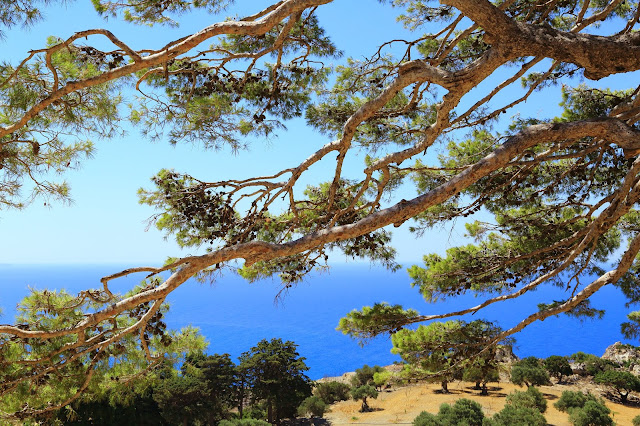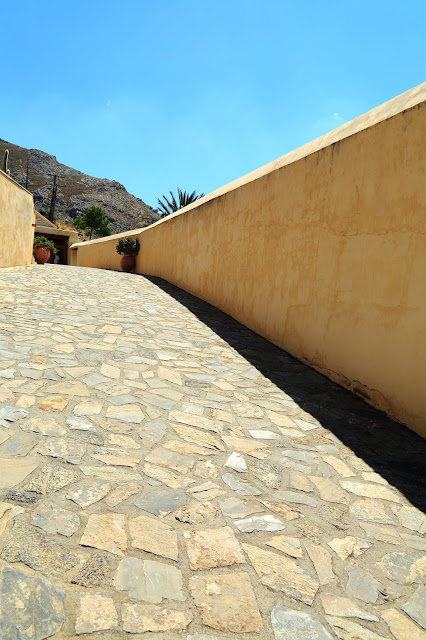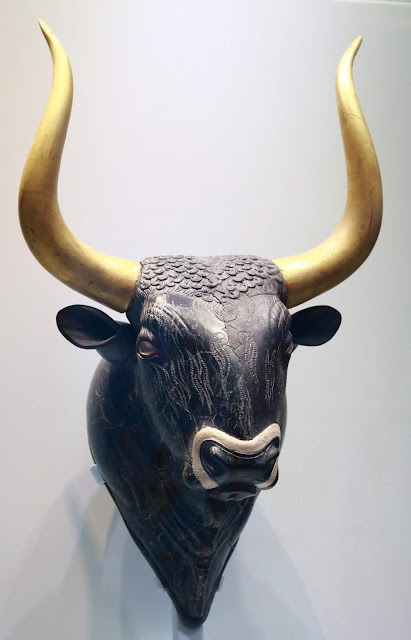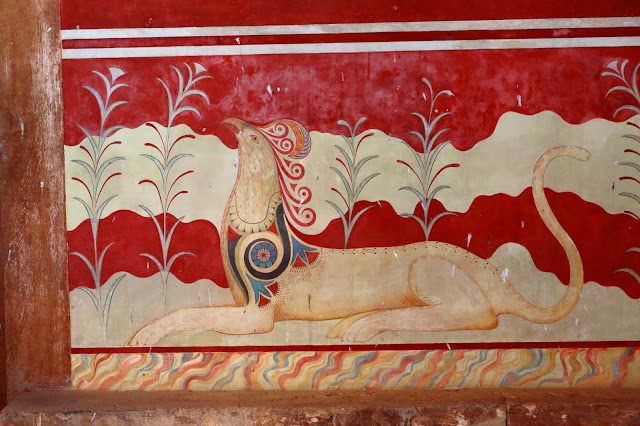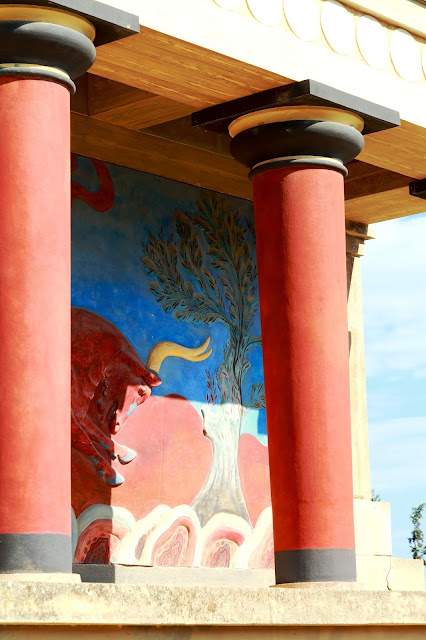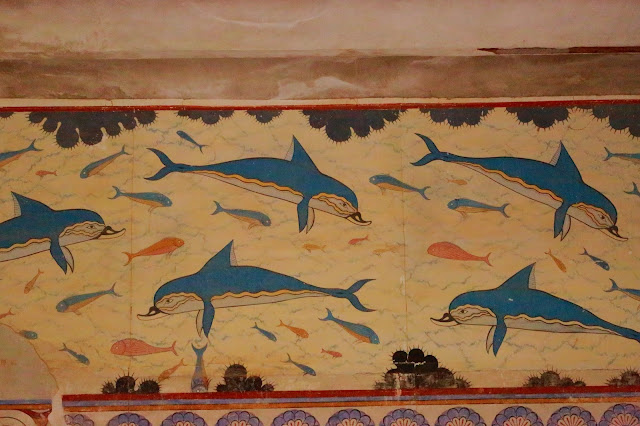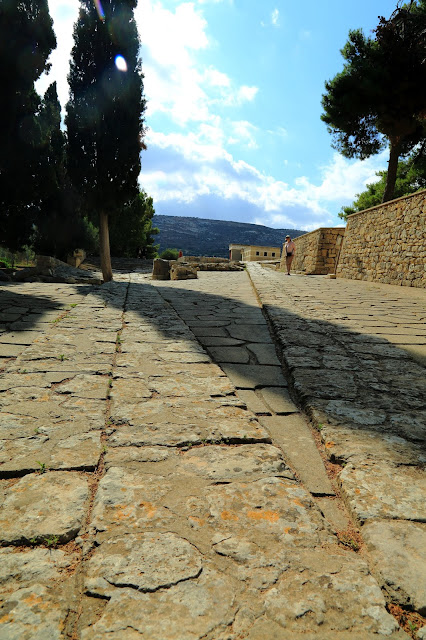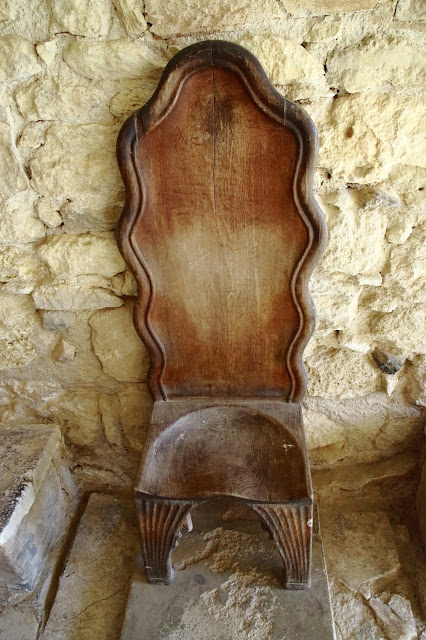The Preveli Monastery. Travelogue about the island of Crete.
Монастырь Превели. Путевые заметки об острове Крит.
To the south of the city of
Rethymno, almost on the southern coast of Crete, is the Holy Patriarchal and
Stavropigialny Monastery of St. John the Theologian Preveli.
К югу от
города Ретимно, почти на южном побережье Крита, расположен Святой Патриарший и
Ставропигиальный Монастырь Святого Иоанна Богослова Превели.
The
road to the monastery passes through the Kourtaliotiko gorge surrounded by
steep cliffs and dizzying precipices, allowing you to fully experience the
power and magnificence of the Cretan nature. Strong wind, reflected and
refracted in countless grottoes and rock cracks, creates a sound similar to
gunfire, justifying the name of the gorge, which comes from the Greek word
“krotos” - meaning “sharp sound”, “bang”, “shot”. Coming out of the car on the
observation deck, I wanted to continuously drive the camera from side to side
and shoot, shoot ... But none of the
photographs conveyed the beauty that was revealed during the movement, it
seemed that nature itself opposes the static.
Дорога в монастырь проходит по ущелью Курталиотико в
окружении крутых скал и головокружительных пропастей, позволяя в полной мере
ощутить мощь и великолепие критской природы. Сильный ветер, отражаясь и
преломляясь в бесчисленных гротах и трещинах скал, создаёт звук похожий на
оружейную стрельбу, оправдывая название ущелья, которое происходит от
греческого слова «кротос» - означающее «резкий звук», «хлопок», «выстрел». Выйдя
из машины на смотровой площадке, хотелось непрерывно водить камерой из стороны
в сторону и снимать, снимать… Но ни одна из фотографий не передала той красоты
которая открывалась во время движения, казалось, что сама природа противится
статике.
Unfortunately,
the road soon got out of the gorge and after a little more time we were at the
goal of our journey - Preveli Monastery.
К сожалению, скоро дорога вышла из ущелья и спустя ещё
немного времени мы оказались у цели нашего путешествия – монастыря Превели.
After
the picturesque gorge, the territory of the monastery was struck by its
severity and asceticism. Limited on three sides by low rocky mountains (spurs
of the White Mountain) and a steep slope to the sea, the monastery, before the
construction of the road, communicated with the villages of the Sfakia area and
the rest of the Rethymno region through impassable gorges.
После живописного ущелья территория монастыря поразила
своей строгостью и аскетичностью. Ограниченный с трех сторон невысокими
скалистыми горами (отрогами Белой Горы) и крутым склоном к морю монастырь, до
строительства дороги общался с деревнями местности Сфакиа и остальной областью
Ретимно через труднопроходимые ущелья.
The exact
date of Foundation of the monastery is unknown, but according to confirmed
information the Holy monastery was formed in the second Byzantine period in the
late X - early XI centuries. During this period, various monastic complexes
began to appear on the southern coast of Crete.
Точная дата основания монастыря неизвестна, но по
подтверждённым сведениям святая обитель была образована во Второй Византийский
период в конце X- начале XI веков. В
этот период на южном побережье Крита начали появляться разнообразные
монастырские комплексы.
The origin
of the name of the monastery is unknown. According to one legend, a monk by the
name of Prevelis was engaged in restoration work in the monastery and since
then to the monastery, and the name came – the Monastery Preveli.
Происхождение названия монастыря точно неизвестно. По
одной из легенд монах по фамилии Превелис занимался реставрационными работами в
обители и с тех пор к монастырю, и пристало имя – Монастырь Превели.
Throughout
the history of Crete, Preveli monastery was at the center of the liberation
wars. Was repeatedly destroyed by invaders. One of the legendary figures of the
Turkish occupation was Igumen Melchizedek Tsouderos (1769-1823) was involved in
many battles with the Ottomans and was fatally wounded on 5 February 1823 in
Polemarchi while trying to fight off the Turks captured the Tower of Kissamos.
На всем протяжении истории Крита монастырь Превели
находился в центре освободительных войн. Был неоднократно разрушаем
захватчиками. Одной из легендарных личностей времён турецкой оккупации был
игумент Мельхиседек Цудерос (1769-1823 гг.), принимавший участие во многих
сражениях с османами и получил смертельное ранение 5 февраля 1823 года в
Полемархи при попытке отбить захваченную турками Башню Киссамос.
After his
death, Nilos Mosshovitis became the head of the monastery, during which a new
cathedral and two bridges over the Megalo Potamos River and its tributary
Burzukos were built. At the same time, the old school at the monastery and the
school of the Holy Spirit were reorganized in a small monastery with the same
name. In later years, the monastery was also glorified by other superiors and
monks: Vladyka Lambis Nikodimos (from 1831 to 1845), Agaghangelos Papavasilios
(from 1864 to 1871) Kallinikos Spitadakis (from 1872 to 1892) and Agafangelos
Laguardos (from 1936) until 1944.)
После его смерти настоятелем монастыря стал Нилос
Мосховитис, при котором были построены новый собор и два моста над
рекой Мегало Потамос и её притоком Бурдзукос. Тогда же была проведена
реорганизация старой школы при монастыре и школы Святого Духа в небольшом
монастыре с таким же названием. В более поздние годы монастырь прославили и
другие настоятели и монахи: владыка Ламбис Никодимос ( с 1831 по 1845 гг.),
Агафангелос Папавасилиос (с 1864 по 1871 гг.) Каллиникос Спитадакис (с 1872 по
1892 гг.) и Агафангелос Лагувардос (с 1936 по 1944 гг.).
During the Second
World War, the monastery Preveli continued to fulfill its historical purpose,
and after the occupation of Crete by the Germans, actively received wounded
soldiers and rescued from captivity and the Greeks, and Australians, and new
Zealanders, and the British. More than 5,000 people found refuge in the
Monastery, and received shelter and food. For this, August 25, 1941 the Nazis
destroyed the Monastery Preveli, and the monks were exiled to prison in Chania.
But at the end of 1943, the Holy abode was ready to work to restore it.
Во время Второй Мировой Войны, Монастырь Превели
продолжал выполнять свою историческую цель, и после оккупации Крита немцами,
активно принимал раненых солдат и спасал от плена и греков, и австралийцев, и
новозеландцев, и англичан. Более 5000 людей обрели в Монастыре убежище, и
получили кров и пищу. За это, 25 августа 1941 года фашисты разрушили Монастырь
Превели, а монахи были сосланы в тюрьмы Ханьи. Но уже в конце 1943-го святая
обитель была готова к работам по её восстановлению.
The monastery of Preveli consists of
two buildings - the Lower Monastery of the Forerunner and the Rear Monastery of
the Theologian.
Монастырь
Превели состоит из двух зданий - Нижнего монастыря Предтечи и Заднего монастыря
Богослова.
The lower monastery is located next
to Megalo Potamo. These are unorganized buildings located on rough terrain. The
cathedral is one room and is located in the center of the courtyard. It is
surrounded by several buildings: a kitchen, an abbey, cells, laboratories,
mills, warehouses, etc. Here, most of the
time and depending on the rural work lived young monks, as well as many workers
and peasants. Unfortunately, the buildings were repeatedly destroyed and looted
by various conquerors.
Нижний монастырь расположен рядом с Мегало
Потамо. Это неорганизованные здания, расположенные на пересеченной местности.
Собор представляет собой одно помещение и находится в центре двора. Его
окружают несколько зданий: кухня, аббатство, кельи, лаборатории, мельницы,
склады и т.д. Здесь большую часть времени и в зависимости от сельских
работ жили молодые монахи, а также многие рабочие и крестьяне. К сожалению,
здания неоднократно были разрушены и разграблены разными завоевателями.
To date, only buildings that tell
about the glorious past of the monastery and remind of the multifaceted
contribution of the monastery to the local community have survived. Icons of
the Cathedral, the work of iconographer mercury from Santorini (1841), as well
as all other sacred objects have recently been returned to the monastery, its
Church Museum.
На сегодняшний
день сохранились только здания, которые рассказывают о славном прошлом
монастыря и напоминают о многогранном вкладе монастыря в местное сообщество.
Иконы Собора, работы иконописца Меркурия с Санторини (1841), а также все другие
священные предметы недавно были возвращены в монастырь, в его церковный музей.
The Museum of the Monastery
preserved a large number of icons (about 100), which at different times adorned
the Cathedral and chapels. Here they were moved for protection and belong to
the period from 1600-1900 ad. The images are distinguished by courage and
originality in the choice and generalization of topics, sometimes even relating
to the doctrinal level. From the point of view of style, they were obviously
influenced by less strict Orthodox trends from the West, especially the
Flemish, and also felt the influence of teachers of the first half of the 17th
century from Rethymno and Chania.
В музее
Монастыря сохранилось большое количество икон (около 100), которые в разные
времена украшали Собор и часовни. Сюда они были перенесены для защиты и
относятся к периоду с 1600 - 1900 гг н.э. Изображения отличаются смелостью и
оригинальностью в выборе и обобщении тем, иногда касающихся даже доктринального
уровня. С точки зрения стиля на них, очевидно, оказали свое влияние менее
строгие православные направления с Запада, особенно фламандцев, а также
чувствуется влияние учителей первой половины 17 века из Ретимно и Ханьи.
A large number of vestments, sacred
vessels, Gospels and silver are added to the wealth of the monastery's
treasures. The library contains about a thousand different volumes of books,
some ancient editions and manuscripts of religious content, as well as prayers,
musical compositions of Byzantine hymns, etc.
Большое
количество облачений, священных сосудов, Евангелий и серебра добавлены к
богатству сокровищ монастыря. Библиотека содержит около тысячи различных томов
книг, некоторые старинные издания и рукописи религиозного содержания, а также
молитвы, музыкальные композиции византийских гимнов, и др.
Многие из
спасенных реликвий и икон выставлены в монастырском музее.
Здесь же представлены отчеты событий, которые произошли во время битвы за Крит.
Здесь же представлены отчеты событий, которые произошли во время битвы за Крит.
The main Shrine of the monastery-the Honest cross of
the monastery Preveli.
Главная Святыня
монастыря - Честной крест монастыря Превели.
The Miraculous Fair Cross of the Patriarchal and
Stavropigialny Monastery of St. John the Theologian of Preveli is a gift from
the kafifmen Efrem Prevelis (1769-1083). According to legend, the Shrine was
brought from Constantinople, and its crystal base contains a particle of the
Holy tree. The honest Cross of Preveli is known to all Cretans because of the
many miracles that come from it. We will describe two cases from the past that
testify to the miraculous power of the cross. Both cases are related to the
futility of any attempts to remove the Cross from the Monastery of St. John the
Divine.
Чудотворный Честной
Крест Святого Патриаршего и Ставропигиального Монастыря Святого Иоанна
Богослова Превели – дар кафигумена Ефрема Превелиса (1769-1083). По преданию
святыня была привезена из Константинополя, и в её хрустальном основании
содержится частица Святого древа. Честной Крест Превели известен всем критянам благодаря множеству чудес, исходящих
от него. Мы опишем два случая из прошлого, свидетельствующие о чудотворной силе
Креста. Оба случая связаны со тщетностью любых попыток вывезти Крест из
Монастыря Святого Иоанна Богослова.
1. In the unfortunate battle that took place in the
village Argeles of Heraklion in August 1823, an armed detachment of militia
from Prevelly under the command of Georgios Tsouderos and monk Mishael Pagonis
fought bravely, but superior to them in numbers and military equipment the
enemy has won, and a Fair Cross fell into the hands of the Turks. Hoping to
find the Cross cavehuman Neil Moshovitis has conducted many investigations and
performed an infinite number of journeys. He visited the battlefield Nurgles
accompanied by the monk Mishael Pagonis who survived the battle and were in the
personal guard of Tsouderos. But despite all attempts to find the Cross, Nilos
returned to the monastery empty-handed. The monastery was in great mourning. But
as a result of constant fasting and continuous prayers, the Cross miraculously
returned to the monastery. In the port of Heraklion, the Turks sold The honest
Cross to Genoese adventurers. When they passed the monastery in November of the
same year, their ship suddenly stopped despite the fair wind. They checked the
entire ship, but found no damage. The ship stood motionless for another three
days. They went to the monastery, which all these days was in front of their
eyes, for provisions and water. They told the monks about their troubles, and
after many hours of conversation the monks suggested that on Board their guests
may be an Honest Cross. Adventurers from Genoa returned the cross to the
monastery and quietly continued their journey.
1. В неудачной битве,
которая произошла в деревне Амургелес области Ираклион в августе 1823,
вооружённый отряд ополченцев из Превелли под командованием Георгиоса Цудероса и
монаха Мисаила Пагониса сражался храбро, но превосходящий их по численности и
военному оснащению противник одержал победу, и Честной Крест попал в руки к
туркам. В надежде отыскать Крест кафигумен Нил Мосховитис провел множество
расследований и совершил бесконечное количество путешествий. Он побывал и на
поле битвы в Амургелес в сопровождении монаха Мисаила Пагониса, который выжил в
этом сражении и был в личной гвардии Цудероса. Но, несмотря на все попытки
найти Крест Нилос вернулся в монастырь с пустыми руками. Монастырь был в
великом трауре. Но в результате постоянных постов и непрерывных молитв Крест
чудесным образом вернулся в монастырь. В порту Ираклиона турки продали Честной
Крест генуэзским путешественникам-авантюристам. Когда в ноябре этого же года
они проплывали мимо монастыря, их корабль внезапно остановился несмотря на
попутный ветер. Они проверили весь корабль, но никакой поломки не обнаружили.
Корабль стоял неподвижно в течение ещё трёх суток. Они направились в монастырь,
который все эти дни находился у них перед глазами, за провизией и водой. Они
рассказали монахам о своих неприятностях, и после многочасовой беседы монахи
предположили, что на борту у их гостей может находится Честной Крест. Искатели
приключений из Генуи вернули крест в монастрыь и спокойно продолжили своё
путешествие.
2. During the German occupation, or rather August 28,
1941, the Nazis seized the monks of the monastery Preveli and looted it. The
reason was the activities of Abbot Agafangel of Lagouvardos and the
contribution of the monastery during the war on the allied side. Mikhail
Papadakis recalls: "more than 5,000 people passed through the monastery,
ate, slept and received help." Leaving the monastery the Germans stole and
Honest Cross. The theft was announced the same evening by monk Manassis
Papadakis. The people accepted the news with horror and despair. No one
expected such sacrilege. The excitement grew as no information was received
about the Cross. But on September 13, at noon, the day before the celebration
of the Exaltation of the Holy and Life-giving Cross of the Lord, the monk
Manassez received a package from a police officer from Chania. The elder signed
the receipt with a trembling hand and being deeply touched, began to thank the
Lord. He opened a valuable parcel and saw in it an Honest Cross, took it out
with reverence and hid it. Then he asked the policeman how the Cross had got to
him. He replied that he was given a Cross by the Germans from Maleme, so he
took him to the monastery. The Germans tried to take away the Shrine on three
different planes, but none of them could take off with a Cross on Board. Frightened,
they decided to return the Cross.
2. Во время немецкой
оккупации, а точнее 28 августа 1941, нацисты схватили монахов монастыря Превели
и разграбили его. Причиной явилась деятельность игумена Агафангела Лагувардоса
и вклад монастыря в войну на стороне союзников. Михаил Пападакис вспоминает:
«более 5000 человек прошли через монастырь, ели, спали и принимали помощь».
Уходя из монастыря немцы украли и Честной Крест. О краже было объявлено в тот
же вечер монахом Манассисом Пападакисом. Народ принял эту новость с ужасом и
отчаянием. Никто не ожидал подобного святотатства. Волнение росло, поскольку
никакой информации о Кресте не поступало. Но 13 сентября, в полдень, за день до
празднования Воздвижения Честного и Животворящего Креста Господня, монах
Манассис получил посылку от полицейского из Хании. Старец дрожащей рукой подписал
квитанцию и будучи глубоко тронут, стал благодарить господа. Он открыл ценную
бандероль и увидел в ней Честной Крест, с благоговением достал его и спрятал.
Затем он поинтересовался у полицейского, как к нему попал Крест. Тот ответил,
что Крест ему дали немцы из Малеме, чтобы он отвёз его в монастырь. Немцы
пытались увезти святыню на трёх разных самолётах, но ни один из них не мог
взлететь с Крестом на борту. Испугавшись, они решили вернуть Крест.
These are just two examples of the many miracles associated
with the Honest Cross. The devotion and faith of the people is expressed in the
following lines: "Go to the Monastery of Preveli, and an Honest Cross will
help you gain health." The cross heals from diseases, especially from eye
diseases. From the moment of finding an Honest cross to the present day, it
determines the life of the monastery and all those who with trepidation and
faith resort to its goodness.
Это всего лишь два
примера из многочисленных чудес, связанных с Честным Крестом. Преданность и
вера людей выражена в следующих строках: «Иди в Монастырь Превели, и Честной
Крест поможет тебе обрести здоровье». Крест исцеляет от болезней, в
особенности, от глазных. С момента обретения Честного Креста до наших дней он
определяет жизнь монастыря и всех, кто с трепетом и верой прибегает к его
благости.





































